light Alfa Romeo 156 2004 Owner handbook (in English)
[x] Cancel search | Manufacturer: ALFA ROMEO, Model Year: 2004, Model line: 156, Model: Alfa Romeo 156 2004Pages: 357, PDF Size: 5.04 MB
Page 55 of 357
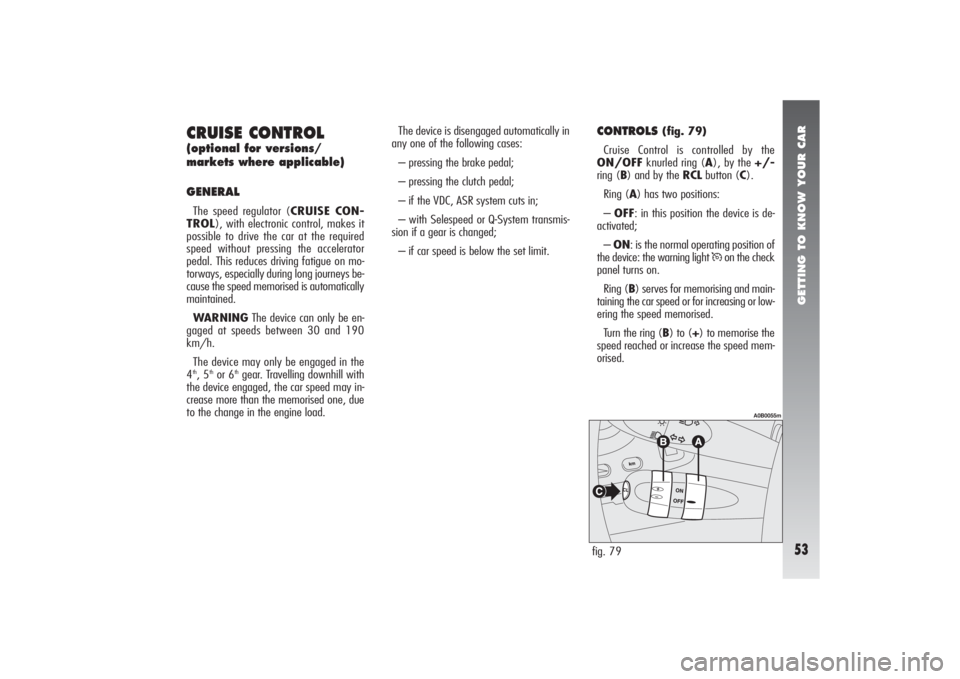
GETTING TO KNOW YOUR CAR53
CRUISE CONTROL(optional for versions/
markets where applicable)
GENERALThe speed regulator (CRUISE CON-
TROL), with electronic control, makes it
possible to drive the car at the required
speed without pressing the accelerator
pedal. This reduces driving fatigue on mo-
torways, especially during long journeys be-
cause the speed memorised is automatically
maintained.
WARNINGThe device can only be en-
gaged at speeds between 30 and 190
km/h.
The device may only be engaged in the
4th, 5
thor 6
thgear. Travelling downhill with
the device engaged, the car speed may in-
crease more than the memorised one, due
to the change in the engine load.The device is disengaged automatically in
any one of the following cases:
– pressing the brake pedal;
– pressing the clutch pedal;
– if the VDC, ASR system cuts in;
– with Selespeed or Q-System transmis-
sion if a gear is changed;
– if car speed is below the set limit.
CONTROLS
(fig. 79)
Cruise Control is controlled by the
ON/OFFknurled ring (A), by the +/-
ring (B) and by the RCLbutton (C).
Ring (A) has two positions:
– OFF: in this position the device is de-
activated;
– ON: is the normal operating position of
the device: the warning light
Ü
on the check
panel turns on.
Ring (B) serves for memorising and main-
taining the car speed or for increasing or low-
ering the speed memorised.
Turn the ring (B) to (+) to memorise the
speed reached or increase the speed mem-
orised.
fig. 79
A0B0055m
Page 57 of 357
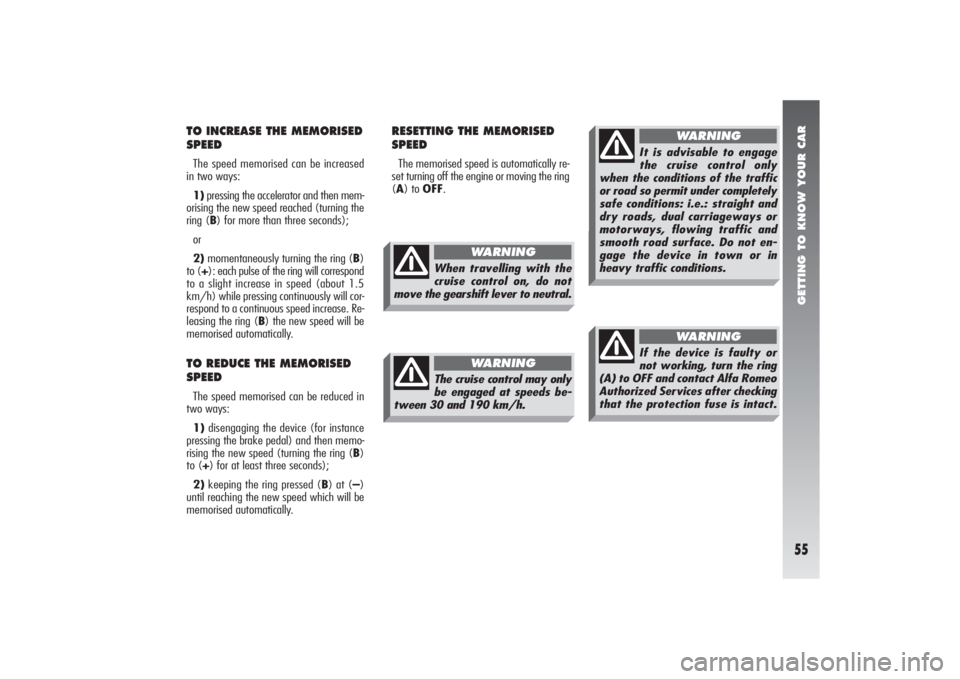
GETTING TO KNOW YOUR CAR55
TO INCREASE THE MEMORISED
SPEEDThe speed memorised can be increased
in two ways:
1)pressing the accelerator and then mem-
orising the new speed reached (turning the
ring (B) for more than three seconds);
or
2)momentaneously turning the ring (B)
to (+): each pulse of the ring will correspond
to a slight increase in speed (about 1.5
km/h) while pressing continuously will cor-
respond to a continuous speed increase. Re-
leasing the ring (B) the new speed will be
memorised automatically.TO REDUCE THE MEMORISED
SPEEDThe speed memorised can be reduced in
two ways:
1)disengaging the device (for instance
pressing the brake pedal) and then memo-
rising the new speed (turning the ring (B)
to (+) for at least three seconds);
2)keeping the ring pressed (B) at (–)
until reaching the new speed which will be
memorised automatically.
RESETTING THE MEMORISED
SPEEDThe memorised speed is automatically re-
set turning off the engine or moving the ring
(A) to OFF.
When travelling with the
cruise control on, do not
move the gearshift lever to neutral.
WARNING
The cruise control may only
be engaged at speeds be-
tween 30 and 190 km/h.
WARNING
It is advisable to engage
the cruise control only
when the conditions of the traffic
or road so permit under completely
safe conditions: i.e.: straight and
dry roads, dual carriageways or
motorways, flowing traffic and
smooth road surface. Do not en-
gage the device in town or in
heavy traffic conditions.
WARNING
If the device is faulty or
not working, turn the ring
(A) to OFF and contact Alfa Romeo
Authorized Services after checking
that the protection fuse is intact.
WARNING
Page 58 of 357
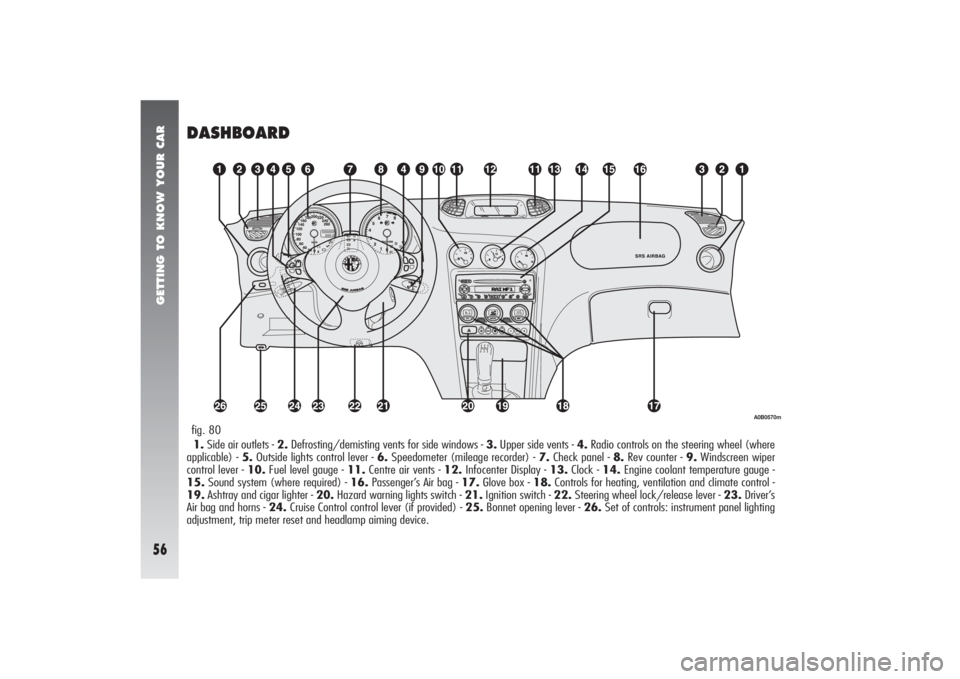
GETTING TO KNOW YOUR CAR56
DASHBOARD1.Side air outlets - 2.Defrosting/demisting vents for side windows - 3.Upper side vents - 4.Radio controls on the steering wheel (where
applicable) - 5.Outside lights control lever - 6.Speedometer (mileage recorder) - 7.Check panel - 8.Rev counter - 9.Windscreen wiper
control lever - 10.Fuel level gauge - 11.Centre air vents - 12.Infocenter Display - 13.Clock - 14.Engine coolant temperature gauge -
15.Sound system (where required) - 16.Passenger’s Air bag - 17.Glove box - 18.Controls for heating, ventilation and climate control -
19.Ashtray and cigar lighter - 20.Hazard warning lights switch - 21.Ignition switch - 22.Steering wheel lock/release lever - 23.Driver’s
Air bag and horns - 24.Cruise Control control lever (if provided) - 25.Bonnet opening lever - 26.Set of controls: instrument panel lighting
adjustment, trip meter reset and headlamp aiming device.fig. 80
A0B0570m
Page 59 of 357
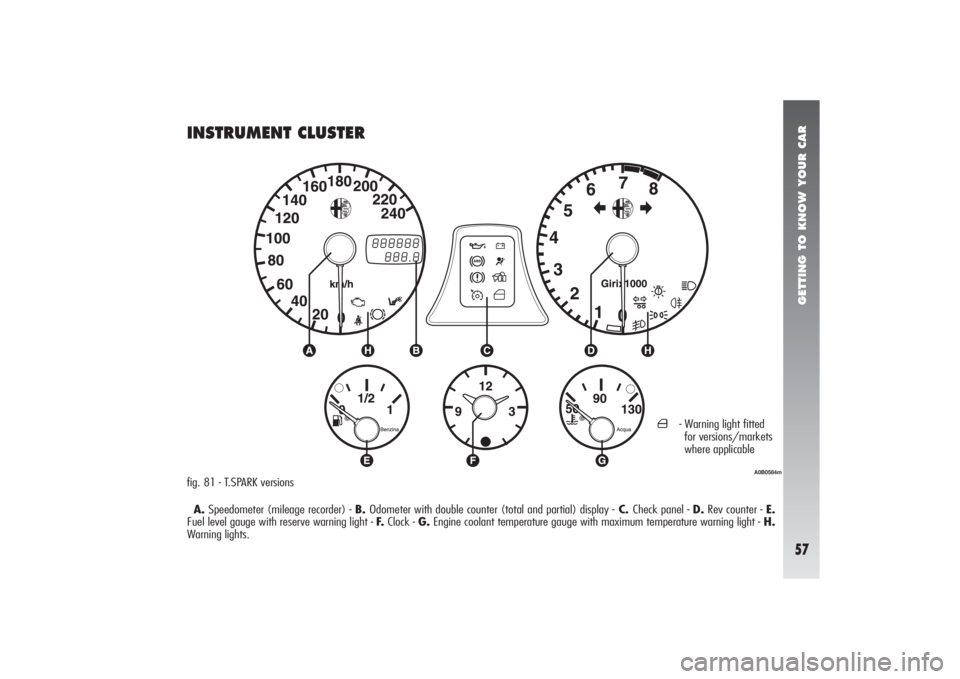
GETTING TO KNOW YOUR CAR57
INSTRUMENT CLUSTERfig. 81 - T.SPARK versions
A.Speedometer (mileage recorder) - B. Odometer with double counter (total and partial) display -C. Check panel - D.Rev counter - E.
Fuel level gauge with reserve warning light - F.Clock - G.Engine coolant temperature gauge with maximum temperature warning light - H.
Warning lights.
A0B0584m
´
- Warning light fitted
for versions/markets
where applicable
Page 60 of 357
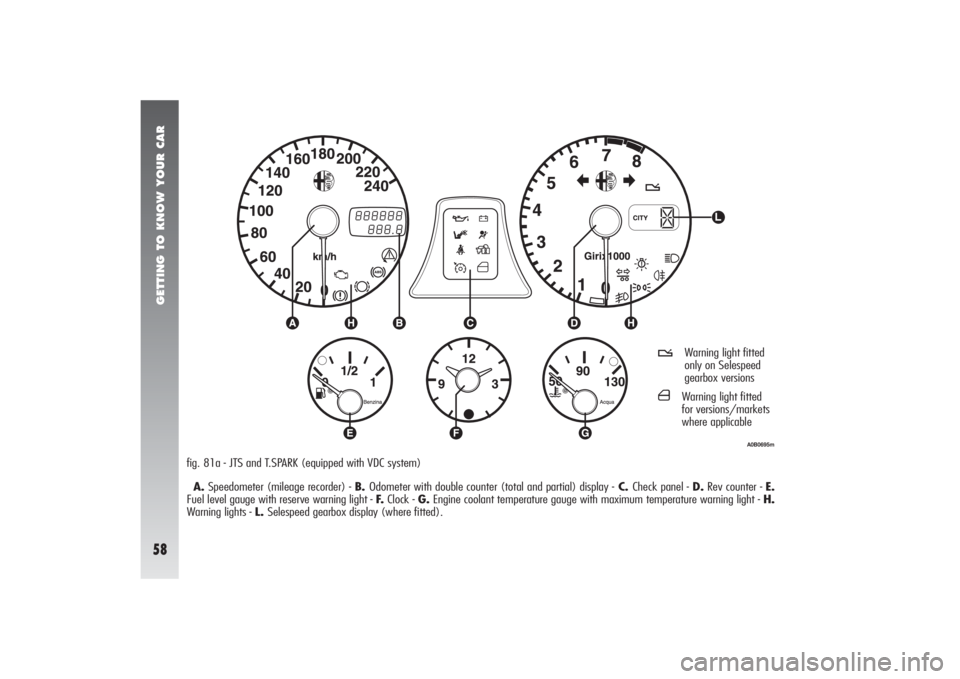
GETTING TO KNOW YOUR CAR58
A0B0695m
fig. 81a - JTS and T.SPARK (equipped with VDC system)
A.Speedometer (mileage recorder) - B. Odometer with double counter (total and partial) display -C. Check panel - D.Rev counter - E.
Fuel level gauge with reserve warning light - F.Clock - G.Engine coolant temperature gauge with maximum temperature warning light - H.
Warning lights - L. Selespeed gearbox display (where fitted).
t
Warning light fitted
only on Selespeed
gearbox versions
´
Warning light fitted
for versions/markets
where applicable
Page 61 of 357
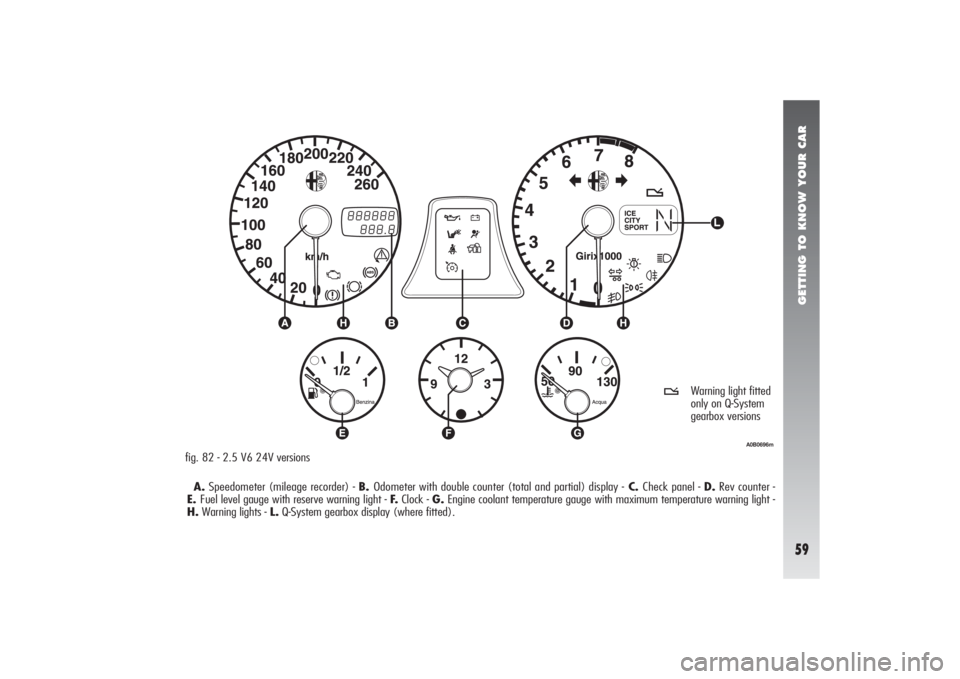
GETTING TO KNOW YOUR CAR59
A.Speedometer (mileage recorder) - B. Odometer with double counter (total and partial) display -C. Check panel - D.Rev counter -
E.Fuel level gauge with reserve warning light - F.Clock - G.Engine coolant temperature gauge with maximum temperature warning light -
H.Warning lights - L.Q-System gearbox display (where fitted).fig. 82 - 2.5 V6 24V versions
A0B0696m
t
Warning light fitted
only on Q-System
gearbox versions
Page 62 of 357
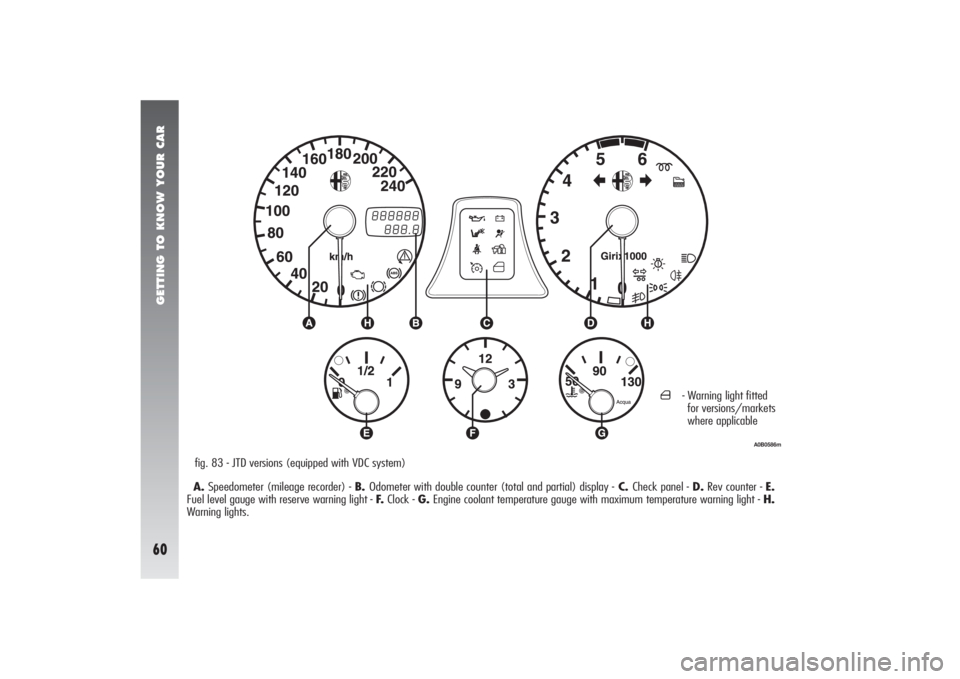
GETTING TO KNOW YOUR CAR60
A.Speedometer (mileage recorder) - B. Odometer with double counter (total and partial) display -C. Check panel - D.Rev counter - E.
Fuel level gauge with reserve warning light - F.Clock - G.Engine coolant temperature gauge with maximum temperature warning light - H.
Warning lights.fig. 83 - JTD versions (equipped with VDC system)
A0B0586m
´
- Warning light fitted
for versions/markets
where applicable
Page 63 of 357
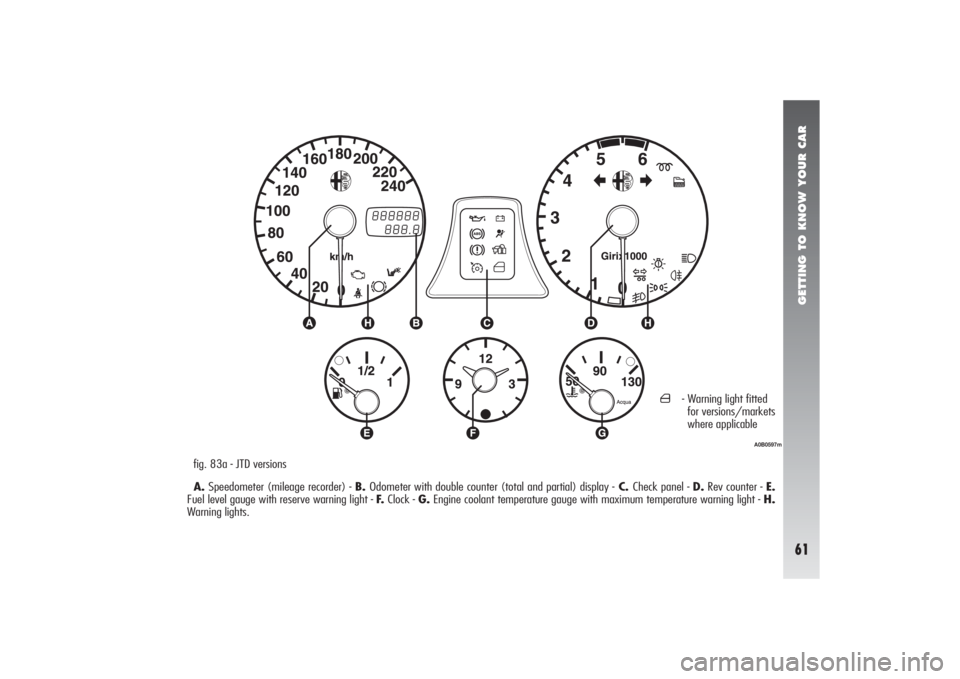
GETTING TO KNOW YOUR CAR61
A0B0597m
fig. 83a - JTD versions
A.Speedometer (mileage recorder) - B. Odometer with double counter (total and partial) display -C. Check panel - D.Rev counter - E.
Fuel level gauge with reserve warning light - F.Clock - G.Engine coolant temperature gauge with maximum temperature warning light - H.
Warning lights.
´
- Warning light fitted
for versions/markets
where applicable
Page 64 of 357
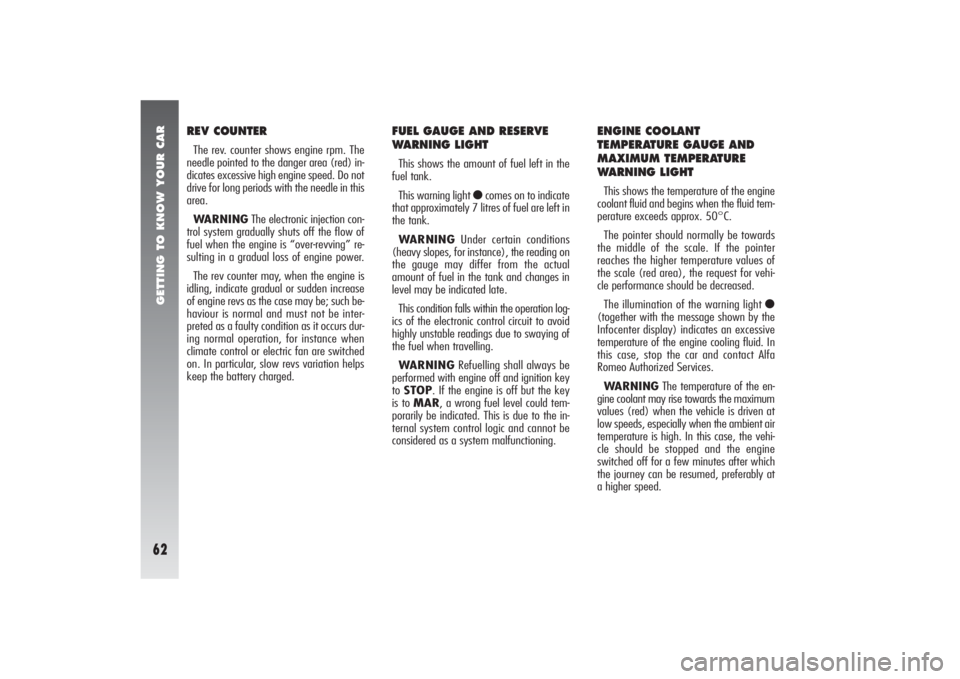
GETTING TO KNOW YOUR CAR62
REV COUNTERThe rev. counter shows engine rpm. The
needle pointed to the danger area (red) in-
dicates excessive high engine speed. Do not
drive for long periods with the needle in this
area.
WARNINGThe electronic injection con-
trol system gradually shuts off the flow of
fuel when the engine is “over-revving” re-
sulting in a gradual loss of engine power.
The rev counter may, when the engine is
idling, indicate gradual or sudden increase
of engine revs as the case may be; such be-
haviour is normal and must not be inter-
preted as a faulty condition as it occurs dur-
ing normal operation, for instance when
climate control or electric fan are switched
on. In particular, slow revs variation helps
keep the battery charged.
FUEL GAUGE AND RESERVE
WARNING LIGHTThis shows the amount of fuel left in the
fuel tank.
This warning light
ç
comes on to indicate
that approximately 7 litres of fuel are left in
the tank.
WARNINGUnder certain conditions
(heavy slopes, for instance), the reading on
the gauge may differ from the actual
amount of fuel in the tank and changes in
level may be indicated late.
This condition falls within the operation log-
ics of the electronic control circuit to avoid
highly unstable readings due to swaying of
the fuel when travelling.
WARNINGRefuelling shall always be
performed with engine off and ignition key
to STOP. If the engine is off but the key
is to MAR, a wrong fuel level could tem-
porarily be indicated. This is due to the in-
ternal system control logic and cannot be
considered as a system malfunctioning.
ENGINE COOLANT
TEMPERATURE GAUGE AND
MAXIMUM TEMPERATURE
WARNING LIGHTThis shows the temperature of the engine
coolant fluid and begins when the fluid tem-
perature exceeds approx. 50°C.
The pointer should normally be towards
the middle of the scale. If the pointer
reaches the higher temperature values of
the scale (red area), the request for vehi-
cle performance should be decreased.
The illumination of the warning light
ç
(together with the message shown by the
Infocenter display) indicates an excessive
temperature of the engine cooling fluid. In
this case, stop the car and contact Alfa
Romeo Authorized Services.
WARNINGThe temperature of the en-
gine coolant may rise towards the maximum
values (red) when the vehicle is driven at
low speeds, especially when the ambient air
temperature is high. In this case, the vehi-
cle should be stopped and the engine
switched off for a few minutes after which
the journey can be resumed, preferably at
a higher speed.
Page 65 of 357

GETTING TO KNOW YOUR CAR63
MILEAGE DISPLAY
(with double meter display)The display shows:
– the mileage on the first line (6 figures)
– the trip meter on the second line (4 fig-
ures)
To reset the trip meter, keep button (A-
fig. 84) pressed for a few seconds.fig. 84
A0B0489m
INFOCENTER DISPLAY
RHEOSTAT LIGHTS
ADJUSTMENT (where
required)This function makes it possible to adjust
the brightness (dimming/brightening) of
the Infocenter display during night and day.
To perform the desired brightness adjust-
ment (night or day), use buttons
â
or ã
,
bearing in mind that:
– if the outside lights are on, the message
BRIGHTN. ADJUST. NIGHT will appear on the
display (fig. 85)
– if the outside lights are OFF, the mes-
sage BRIGHTN. ADJUST. DAY will appear on
the display (fig. 86).Pressing button
â
, or after about 5 sec-
onds from last operation performed, returns
to previous screen.
WARNING During failure indication dis-
playing, brightness cannot be adjusted since
under these conditions the display gets au-
tomatically to max. brightness.
fig. 85
A0B2124g
fig. 86
A0B2125g